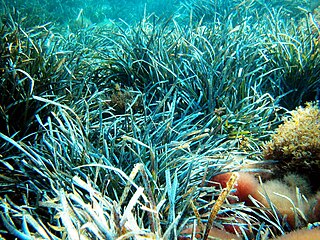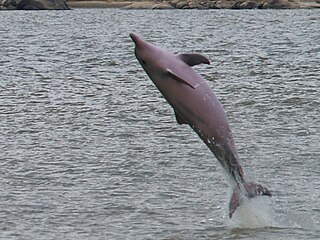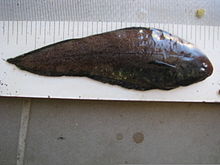The Bradyrhizobiaceae are a family of bacteria, with 10 genera. They include plant-associated bacteria such as Bradyrhizobium, a genus of rhizobia associated with some legumes. It also contains animal-associated bacteria such as Afipia felis, formerly thought to cause cat-scratch disease. Others are free-living, such as Rhodopseudomonas, a purple bacterium found in marine water and soils. The strain Rhodopseudomonas palustris DX-1 can generate an electric current with no hydrogen production, a trait being explored in the development of the microbial fuel cell. The genus Afipia has also been found in the atmosphere, where it uses methylsulfonylmethane as a carbon source.

Pleuronectidae, also known as righteye flounders, are a family of flounders. They are called "righteye flounders" because most species lie on the sea bottom on their left sides, with both eyes on their right sides. The Paralichthyidae are the opposite, with their eyes on the left side. A small number of species in Pleuronectidae can also have their eyes on the left side, notably the members of the genus Platichthys.

Doryanthes is the sole genus in the flowering plant family Doryanthaceae. The genus consists of two species, D. excelsa and D. palmeri, both endemic natives of the coast of Eastern Australia. Doryanthaceae is part of the order Asparagales.

Brachaelurus is the sole genus of sharks in the family Brachaeluridae in the order Orectolobiformes. Only two species of blind sharks occur, both of which are native to shallow coastal waters up to 110 m (360 ft) deep, off the eastern coast of Australia.

The Atlantic weasel shark is a weasel shark of the family Hemigaleidae, found in the eastern Atlantic Ocean. Also known as the little tiger shark, it is the only species of the genus Paragaleus to have been recorded off the western coast of Africa. It is one of four species of small sharks within the carcharhinoid genus Paragaleus, including Paragaleus leucolomatus, Paragaleus tengi, and Paragaleus randalli. It also one of eight species within the weasel shark family, Hemigaleidae. It is currently considered by the International Union for Conservation of Nature (IUCN) as data deficient due to lack of availability of specific information on catches and population trends of the species.

Micronomus norfolkensis is a species of molossid bat, a family of flying mammals. The bat is endemic to Australia, where it occurs from southeastern Queensland to eastern New South Wales. They are the sole species of genus Micronomus and referred to by variations on east-coast free-tailed bat.

Zaniolepis is a genus of scorpaeniform fish native to the eastern Pacific Ocean. Z. frenata is known to have been a source of food to the Native American inhabitants of San Nicolas Island off the coast of southern California, United States during the Middle Holocene.

Posidonia is a genus of flowering plants. It contains nine species of marine plants ("seagrass"), found in the seas of the Mediterranean and around the south coast of Australia.
The northern rock sole is a flatfish of the family Pleuronectidae. It is a demersal fish that lives on sand, mud and gravel bottoms at depths of up to 700 metres (2,300 ft), though it is most commonly found between 19 and 246 metres. Its native habitat is the temperate waters of the northern Pacific, from Puget Sound to Alaska, the Aleutian Islands and across the Bering Sea to the Kuril Islands and the Sea of Okhotsk. Males grow up to 69 centimetres (27 in) in length, whilst females can reach 49 centimetres (19 in). The maximum recorded lifespan is 18 years.

The dolphin genus Sotalia is considered to have two member species with the classification of Sotalia guianensis as a distinct species from Sotalia fluviatilis in 2007. This was a result of recent morphometric analyses, as well as mitochondrial DNA analysis.

Agastachys odorata, commonly known as the white waratah, is the sole member of the genus Agastachys in the protea family. It is an evergreen shrub to small tree and is endemic to the heaths and button grass sedgelands of western Tasmania. It occurs most often in moist heath and scrub and occasionally in the alpine regions, but generally prefers well-drained but poor soils. It can grow in some rainforests where it forms a small tree but is normally a shrub in all other situations. The heaviest concentrations are along the island's south coast. Its leaves are dark green, hairless and almost succulent. Masses of white flowers are produced in erect spikes from the ends of the branches. Measuring 8 to 12 cm high, they appear in January and February.

The Scombrinae are a subfamily of ray-finned bony fishes in the family Scombridae. Of the 51 species in the Scombridae, 50 are in Scombrinae – with the sole exception being the butterfly kingfish, which is placed in the monospecific subfamily Gasterochismatinae.

Gymnachirus is a genus of American soles native to the Atlantic coast of the Americas.
Barnardichthys fulvomarginata is a species of sole endemic to the coasts of South Africa. This species grows to a length of 26 centimetres (10 in) TL. This species is the only known member of its genus.
Paradicula setifer is a species of sole known only from the Pacific coast of Australia. This species is the only known member of its genus.
Rendahlia jaubertensis is a species of sole native to the Pacific coast of Australia. This species is the only known member of its genus.

Solea is a genus of soles from the Indo-Pacific and East Atlantic Oceans, and the Mediterranean Sea.
Synapturichthys kleinii, Klein's sole, is a species of sole found in the Mediterranean Sea and along the Atlantic coast of Africa, just barely entering the Indian Ocean in South Africa. This species grows to a length of 40 centimetres (16 in) TL, though most only reach around 15 centimetres (5.9 in) TL, and is of economic importance. This species is the only known member of its genus.
Malagasia is a monotypic genus of trees in the family Proteaceae. The sole species is Malagasia alticola, endemic to Madagascar.

Emaravirus is a genus of plant viruses and the sole genus in the family Fimoviridae. The genus has 11 species. The type species European mountain ash ringspot-associated emaravirus is associated with a leaf mottling and ringspot disease of European mountain ash Sorbus aucuparia. It can be transmitted by grafting and possibly mites.













